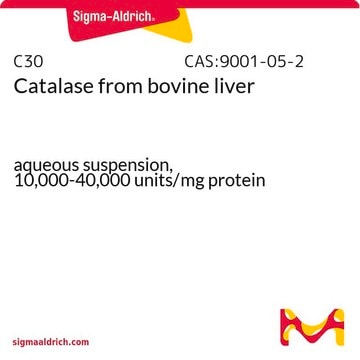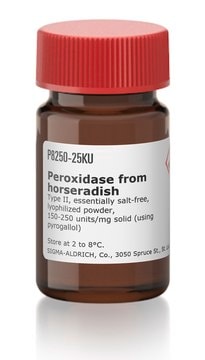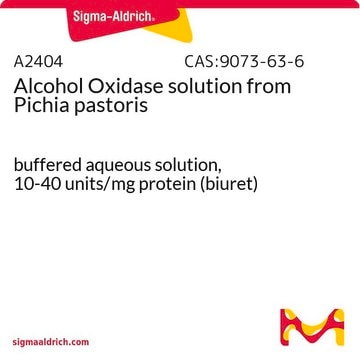This enzyme is from D. Dendroides and is recombinantly produced from Yeast in an animal component free fermentation process.
G7400
Galactose Oxidase from Dactylium dendroides
lyophilized powder, ≥3,000 units/g solid
Sinónimos:
D-Galactose:oxygen 6-oxidoreductase
Seleccione un Tamaño
MXP 2,483.00
Fecha estimada de envío15 de abril de 2025
Seleccione un Tamaño
About This Item
MXP 2,483.00
Fecha estimada de envío15 de abril de 2025
Productos recomendados
biological source
fungus (Dactylium dendroides)
Quality Level
form
lyophilized powder
specific activity
≥3,000 units/g solid
storage temp.
−20°C
¿Está buscando productos similares? Visita Guía de comparación de productos
General description
Application
Biochem/physiol Actions
2-Deoxy-D-galactose, lactose, melibiose, raffinose and stachyose react with galactose oxidase in the peroxidase:o-tolidine system.
Essentially no oxidation of D-glucose, L-galactose, L-arabinose or D-glucuronate has been observed.
Unit Definition
Related product
inhibitor
signalword
Danger
hcodes
pcodes
Hazard Classifications
Resp. Sens. 1
Storage Class
11 - Combustible Solids
wgk_germany
WGK 1
flash_point_f
Not applicable
flash_point_c
Not applicable
Elija entre una de las versiones más recientes:
Certificados de análisis (COA)
¿No ve la versión correcta?
Si necesita una versión concreta, puede buscar un certificado específico por el número de lote.
¿Ya tiene este producto?
Encuentre la documentación para los productos que ha comprado recientemente en la Biblioteca de documentos.
Los clientes también vieron
-
Hello, I have bought this enzyme for some assays in our lab in January 2024. I would like to ask how this enzyme is produced? Is it recombinant (E. coli or yeast) or is it directly isolated from Dactilium dendroides? Looking forward to hearing from you!
1 answer-
Helpful?
-
Active Filters
Nuestro equipo de científicos tiene experiencia en todas las áreas de investigación: Ciencias de la vida, Ciencia de los materiales, Síntesis química, Cromatografía, Analítica y muchas otras.
Póngase en contacto con el Servicio técnico













